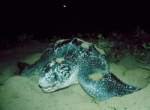
Dermochelys coriacea, the Leatherback Turtle, is the only extant member of the family Dermochelyidae, which has a fossil record stretching back to the Eocene (Ernst and Barbour 1989). As the largest living turtle, it frequently attains an adult weight of 295-544 kg and can grow to be 1.35-1.780 m in carapace length (GNHM). Compared to other species of sea turtle, the front flippers are unusually long relative to body length and may span 270 cm in an adult male.
In addition to holding the record for largest extant turtle, D. coriacea is also recognized for having the largest range of any known reptile. Truly cosmopolitan, it has been found in nearly all the world's oceans, preferring the warmer and temperate regions of the Atlantic, Pacific, and Indian Oceans, but often venturing into cooler water in search of its favorite food, jellyfish. Overall, Leatherbacks are opportunistic feeders and will also prey on crustaceans, fish, squid, octopus, sea urchins, shelled mollusks, tunicates, seaweed, and even blue-green algae (Ernst and Barbour 1989). It is not unheard of for these giant turtles to dive in excess of 1,000 m when seeking out a meal.
Leatherbacks are able to dive deeper and live in colder waters than other sea turtles due to their ability to maintain a core body temperature up to 18 degrees (C) higher than the ambient temperature (Frair, Ackman, and Mrosovsky 1972). This adaptation arises from a countercurrent heat exchange system found in the appendages of this species (Greer, Lazell, and Wright 1973).
Perhaps the most notable characteristic of Dermochelys coriacea is its distinctive carapace structure. Leatherbacks have lost the shell bones and keratinous scutes that comprise the shells of most turtles, with only the nuchal bone of the carapace retained and the plastron bones reduced to a thin, peripheral rim (Ernst and Barbour 1989). Ernst and Barbour (1989) suggest that the small plastron bones are homologous to the epiplastra, hyoplastra, hypoplastra, and xiphiplastra found in most other species. In place of the horny scutes is a tough, rubbery skin, in which many small, bony plates are embedded. In the carapace, the largest of these plates form seven pronounced ridges, or keels, and in the plastron they produce five. Other distinctive osteological characteristics include a toothlike cusp at the premaxillary-maxillary suture (Ernst and Barbour 1989), visible even in hatchlings, and an unossified articular (Gaffney 1979).
Sadly, Leatherbacks are endangered worldwide, both as a result of poaching and indirect human causes (IUCN for more info). In some areas, this and other sea-turtle species are often captured for food, and frequent egg harvesting and accidental capture in fishing nets only add to conservation issues. It is also not uncommon for dead specimens to wash up onshore, having choked on plastic bags most likely mistaken for jellyfish.

About the Species
This specimen, a hatchling leatherback turtle, was collected from Costa Rica, Limon Province, Tortuguero on July 31 1956 by L. H. Ogren. It was made available to The University of Texas High-Resolution X-ray CT Facility for scanning courtesy of the Florida Museum of Natural History. Funding for scanning was provided by a National Science Foundation Digital Libraries Initiative grant to Dr. Timothy Rowe of The University of Texas at Austin.

About this Specimen
This specimen was scanned by Matthew Colbert on 29 October 2003 along the coronal axis for a total of 795 1024x1024 pixel slices. Each slice is 0.138 mm thick, with an interslice spacing of 0.138 mm and a field of reconstruction of 56.5 mm. The head of this specimen was isolated in VGStudioMax by rendering only slices 1-195 from the entire body scan.

About the
Scan
Literature
Bickham, J. W., and J. L. Carr. 1983. Taxonomy and phylogeny of the higher categories of cryptodiran turtles based on a cladistic analysis of chromosomal data. Copeia 1983:918-932.
Ernst, C. H., and R. W. Barbour. 1989. Turtles of the World. Smithsonian Institution Press, Washington D. C. 311 pp.
Frair, w., R.G. Ackman, and N. Mrosovsky. 1972. Body Temperature of Dermochelys coriacea: warm turtle from cold water. Science 177:791-793.
Gaffney, E. S. 1979. Comparative cranial morphology of Recent and fossil turtles. Bulletin of the American Museum of Natural History. 164:67-376.
Greer, A.E., J.D. Lazell, and R.M. Wright. 1973. Anatomical evidence for a countercurrent heat exchange in the leatherback turtle (Dermochelys coriacea). Nature 244:181.
Nick, L. 1913. Das Kopfskelet von Dermochelys coriacea L. Zoologische
Jahrbücher, Abteilung für Anatomie und Ontogenie der Tiere, 33:1-238.
Schumacher, G.-H. 1972. Die Kopf- und Halsregion der Lederschildkrote
Dermochelys coriacea (Linnaeus 1766). Abhandlungen der Akademie der
Wissenshaften der DDR, 2:7-92.
Shaffer, H. B., P. Meylan, and M. L. McKnight. 1997. Tests of turtle phylogeny: molecular, morphological, and paleontological approaches. Systematic Biology 46:235-268.
Wegner, R. N. 1959. Der Schadelbau der Lederschildröte Dermochelys coriacea Linne (1766). Abhandl. Deutsche Akad. Wiss. Berlin, Kl. Chemie, Geol., Biol.
4:3-80.
Zangerl, R. 1969. The turtle shell, p. 311-339. In: Biology of the Reptilia, Morphology A, Volume 1. C. Gans, A. d. A. Bellairs, and T. S. Parsons (eds.). Academic Press, London.
Links
Dermochelys coriacea on the Animal Diversity Web (Univ. of Michigan Museum of Zoology).
Images of of D. coriacea and other sea turtles on the World Chelonian Trust webpage.
Information on the life history and population status of D. coriacea on the U.S. Fish and Wildlife Service webpage.
The research website of Dr. Eugene S. Gaffney
Information on the conservation and status of D. coriacea on the IUCN Red List of threatened species.
D. coriacea on the Gerogia Museum of Natural History web site.

Literature
& Links
Additional
Imagery


